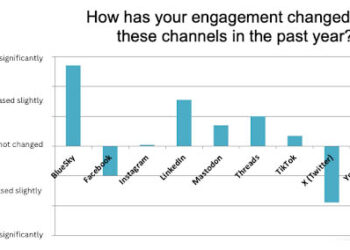
Publishers earn their keep by (a) identifying properties that have the potential to reach a wide audience (b) enhancing those properties and (c) bringing those properties to the largest possible audience. The first of these functions is called editorial, the second is production, and the third is marketing.
Authors are prepared to forgive everything but the third: the undermarketed author will eventually seek other professional relationships, whether those are with other publishers, alternative services, or via self-publishing. Conversely, the publisher who satisfies expectations on that third point can pretty much slough off critics and annoyances of just about any kind, whether in the form of rival services, government mandates, or even instances of piracy and other unauthorized or unwelcome usage. It’s a marketing game, fellas: get that right and the world may grumble but will never turn away.
To be a good marketer nowadays is not easy, in part because the number of options is so vast that no one can take advantage of them all, and in part because some of the new venues are hard to understand, hard to integrate into an overall marketing plan. Are the unauthorized books circling the globe in torrent streams piracy pure and simple or perhaps an emerging way to bring publications to the attention of new readers? Will the deposit of an article in an institutional repository help or hurt the sale of the journals from which the article was taken? And what do we make of all the new consumer social media services? Is Facebook meaningful for STM publishers? And what the heck is Twitter anyway?
I have been struggling with this question for some time now, and a big reason for it is that the words “online” and “cyberspace” no longer seem entirely obvious to me. We know what it means to go online–you are reading this blog post online–but is it still “online” to read a book on a Kindle reader? Is an iPhone app online or something else? And as for cyberspace, where exactly is that when you load an Android app or curl up with a clutch of PDFs and read them on an iPad? It’s probably worth noting that the novel where the term “cyberspace” first appeared, William Gibson’s “Neuromancer,” was published in 1984. The commercial World Wide Web was still a decade away, Google and Facebook did not yet exist, Stevan Harnad had not yet unleashed his “subversive proposal” (1994), and it would be 23 years before the iPhone altered the landscape forever.
For us to be more effective marketers, we need a new paradigm, a new metaphor.
My friend Ron Martinez has come up with the best new way of looking at this that I have come across. Ron is the founder of Aerbook, about which more in a minute. I should disclose that in the distant past, I was Ron’s publisher, when he was developing computer games for the Star Trek franchise.
Let’s take a look at the metaphors.
Ron’s view is that we have been using geographical metaphors (think about the implications of “cyberspace”) to define how we interact with digital media. So, for example, we “go” to a Web site–and it is a “site,” a place located in metaphoric space. Whether we do this on foot (metaphorically and virtually) or car or by spaceship is not the important aspect; what is important is that we travel, we are seekers. Relevant information is somewhere “out there” if only we can find it.
But social media changes that. The metaphor for social media is the stream: We stand in the middle of it and it flows by. In effect, we are stationary, but the world around us is moving. We are the constant point of reference. This is true whether you use Mendeley or Facebook or are simply sorting through the flood of email that comes from joining a virtual community. We all complain about being inundated by the flood; we are standing in the middle of the river and the water rushes by. We have moved from cyberspace to the stream. The question for publishers is not how to get people to come to your site (valuable though that still may be) but how to place commercial and monetizable messages into that stream so that the user, who is positioned as the point of reference for his or her personal flow, can be persuaded to make a purchase or to take some action that can lead to a purchase.
At the recent PSP conference in Washington I saw an excellent presentation by someone responsible for social media marketing at a large STM publisher. This organization had devoted money to social media, had hired an expert, and now had a network of venues, all of which were designed to lead participants back to the company’s publications. The activity was accompanied by analytics (how many users are active on each venue, how often do they click on links, etc.). It was overall one of the most striking presentations on social media for STM publishers that I have yet seen.
Without faulting that program, however, there are 2 inherent limitations to it. The first is that it requires a user to leave the social media platform to return to old-fashioned cyberspace in order to interact with the publisher’s primary content. In other words, the user is asked to switch metaphors, from the stream to cyberspace. This is probably the best that can be expected with most current platforms, but it is an inelegant and inefficient way to keep users fully engaged. If you have to leave the publisher’s Pinterest display (of insects or descriptions of molecules or illustrations of concepts in physics) to get to the underlying research content, which is found in journals that appear on a Web site, how do you get the user back to your program on Pinterest?
Back to Aerbook. Ron has come up with what he calls “native commerce,” the ability to display and monetize content from within a social media platform–without leaving that platform. Aerbook, that is, is a virtual bookstore (really a retailer of any kind of content, but Aerbook’s first area of concentration is trade books) that sits within the stream. Click on a link and you can learn more about a book, read an excerpt, or make a purchase, without leaving Aerbook or the social media platform that is wrapped around it. If someone shares the link, the social media metadata goes with it, essentially making all your online friends and followers into the hosts of a book kiosk right in their own streams of content, visible in turn to their friends and followers.
Aerbook will not be the last company to move to this deeper level of integration of content, commerce, and social media, but it points to the implications of the switch of metaphors. Now all that useless and noisy buzz of social media, which can sometimes seem like an adolescent time-waster, can be brought within the marketing purview of a publisher. Shrewd scholarly publishers will be moving into this area, the better to enhance discovery, usage, and purchase. Viewed in this way, what appeared to be the built-in advantages for discovery of open access content don’t seem all that remarkable.
I said that there were 2 inherent limitations to the presentation I witnessed, and the second one is that a publisher has to get people to participate in its social media activity in the first place. Why would anyone “friend” you on Facebook if all you do is send out ads? Users and customers have to be brought along slowly, and that means creating an environment where the engagement is with the publisher’s stream first and foremost; the embedded links come later and can only be used sparingly or they will alienate the user. This means that publishers operating in social media have to create a second category of content–news feeds in a particular topic area, for example–in order to attract friends and followers. There is a cost to this and it must be conducted with a high level of editorial intelligence.
On the other hand, if the mechanisms for social-media-based commerce become more familiar and easier to implement, then a business plan–at last!–for social media marketing can be drawn up and implemented. Social media then goes from being a trendy expense with uncertain significance to a central and quantifiable part of every company’s business activity.
And that’s what gets in the way of the adoption of new technology, is it not? Not a lack of curiosity or an uwillingness to make investments but the need for a clear business case. A presence on Instagram is just an expense, but when it is paired with a strategy for monetization, it becomes an investment with a forecast payoff. That’s why we will be seeing more marketing in the stream, because (paraphrasing Willie Sutton) that’s where the money is.
Discussion
7 Thoughts on "Marketing in the Stream"
“The undermarketed author will eventually seek other professional relationship” I say “Fine. Let them” All authors think they are undermarketed. I’ve yet to meet an author who said “You overmarketed my last book.”
Joe:
A good post with some interesting thoughts. I totally agree that marketing is important, and being in the right place at the right time is key. However, I take issue with a couple of your points. For the most part, people are not going to Facebook and Pinterest (to name just a few) to have serious interactions with their peers on STM subjects. Do a quick search in Pinterest on “Physics” or “Molecular biology”. What you find are some great memes that people in the field would appreciate. You don’t see any serious science taking place.
What these sites are good for is prospecting … getting people to self-identify as interested in a subject area. Get them to exchange their name and email address for something fun or useful, then market to them with more appropriate media.
LinkedIn has created forums where, theoretically, serious business/scientific conversations can take place. Have you looked at a LinkedIn forum recently? It is full of self-promotion and very little serious discussion. The development of web browsers with multiple tabs has made it possible to flip between sites easily, taking away most of the need for “embedded” content within a social site.
I suspect that the statement with which Joe begins this piece does not apply as much to scholarly publishing as it does to trade publishing. Otherwise, why would authors not be flocking to OA monograph publishing instead of remaining satisfied with having 300 copies of their book held by academic libraries and maybe 100 more bought by fellow scholars? I can also tell you from experience that an academic author is going to be much more angry at the failure of her publisher to submit the book for the top book prize offered by her scholarly society or to send a review copy to the main journal in her field than to run an ad for it in, say, the New York Review of Books. Both of those are marketing failures, but they have little or nothing to do with reaching the largest possible audience.
I also disagree that “good marketing” can make up for bad acquisitions and production. If an author has a negative experience during peer review, contract negotiation, copy-editing, proofreading, and design, it doesn’t really matter what you do marketing-wise. You will have one unhappy author on your hands.
I agree that authors rarely feel they were over-marketed. You need to be very proactive about creating marketing campaigns with a strong call to action and tight follow-up to stay in touch with prospective customers.
This is a commercial article for Aerbook which did not come up with any new idea. Is there any difference between Aerbook and Amazon. I seen nothing different.



